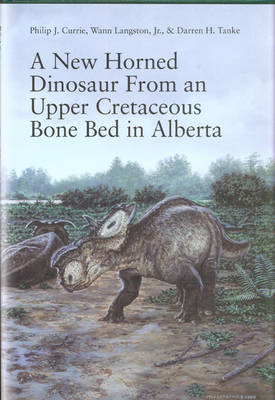
A New Horned Dinosaur from an Upper Cretaceous Bone Bed in Alberta
Seiten
2008
Canadian Science Publishing (NRC Research Press) (Verlag)
978-0-660-19819-4 (ISBN)
Canadian Science Publishing (NRC Research Press) (Verlag)
978-0-660-19819-4 (ISBN)
- Titel ist leider vergriffen;
keine Neuauflage - Artikel merken
A monographic treatment of a horned (ceratopsid) dinosaur in almost a century that presents one of the closest looks at the anatomy, relationships, growth and variation, behavior, ecology and other biological aspects of a single dinosaur species.
In the first monographic treatment of a horned (ceratopsid) dinosaur in almost a century, this monumental volume presents one of the closest looks at the anatomy, relationships, growth and variation, behavior, ecology and other biological aspects of a single dinosaur species. The research, which was conducted over two decades, was possible because of the discovery of a densely packed bone bed near Grande Prairie, Alberta. The locality has produced abundant remains of a new species of horned dinosaur (ceratopsian), and parts of at least 27 individual animals were recovered. This new species of Pachyrhinosaurus is closely related to Pachyrhinosaurus canadensis, which is known from younger rocks near Drumheller and Lethbridge in southern Alberta, but is a smaller animal with many differences in the ornamental spikes and bumps on the skull. The adults of both species have massive bosses of bone in the positions where other horned dinosaurs (like Centrosaurus and Triceratops) have horns. However, juveniles of the new species resemble juveniles of Centrosaurus in having horns rather than bosses. Skull anatomy undergoes remarkable changes during growth and the horns over the nose and eyes of the Pachyrhinosaurus juveniles transform into bosses; spikes and horns develop on the top of and at the back of the frill that extends back over the neck. No cause has been determined for the apparent catastrophic death of the herd of Pachyrhinosaurus from the Grande Prairie area, but it has been suggested that such herds may have been migratory animals. In addition to the main descriptive paper, the volume includes information on the distribution of bones within the bone bed itself, and a cutting-edge digital treatment of CT-scan data of the fossils to reveal the anatomy of the animal's brain!
In the first monographic treatment of a horned (ceratopsid) dinosaur in almost a century, this monumental volume presents one of the closest looks at the anatomy, relationships, growth and variation, behavior, ecology and other biological aspects of a single dinosaur species. The research, which was conducted over two decades, was possible because of the discovery of a densely packed bone bed near Grande Prairie, Alberta. The locality has produced abundant remains of a new species of horned dinosaur (ceratopsian), and parts of at least 27 individual animals were recovered. This new species of Pachyrhinosaurus is closely related to Pachyrhinosaurus canadensis, which is known from younger rocks near Drumheller and Lethbridge in southern Alberta, but is a smaller animal with many differences in the ornamental spikes and bumps on the skull. The adults of both species have massive bosses of bone in the positions where other horned dinosaurs (like Centrosaurus and Triceratops) have horns. However, juveniles of the new species resemble juveniles of Centrosaurus in having horns rather than bosses. Skull anatomy undergoes remarkable changes during growth and the horns over the nose and eyes of the Pachyrhinosaurus juveniles transform into bosses; spikes and horns develop on the top of and at the back of the frill that extends back over the neck. No cause has been determined for the apparent catastrophic death of the herd of Pachyrhinosaurus from the Grande Prairie area, but it has been suggested that such herds may have been migratory animals. In addition to the main descriptive paper, the volume includes information on the distribution of bones within the bone bed itself, and a cutting-edge digital treatment of CT-scan data of the fossils to reveal the anatomy of the animal's brain!
| Zusatzinfo | Figs, illus, tabs |
|---|---|
| Sprache | englisch |
| Themenwelt | Naturwissenschaften ► Geowissenschaften ► Mineralogie / Paläontologie |
| ISBN-10 | 0-660-19819-3 / 0660198193 |
| ISBN-13 | 978-0-660-19819-4 / 9780660198194 |
| Zustand | Neuware |
| Haben Sie eine Frage zum Produkt? |
Mehr entdecken
aus dem Bereich
aus dem Bereich
Buch | Softcover (2024)
Shaker (Verlag)
CHF 27,70
An Optimist's Guide to the Historical Sciences
Buch | Softcover (2024)
MIT Press (Verlag)
CHF 48,35


